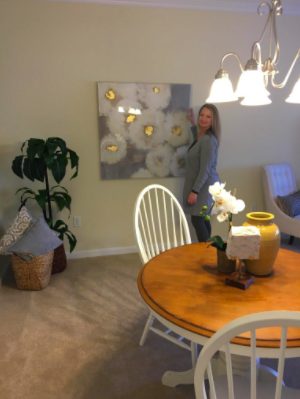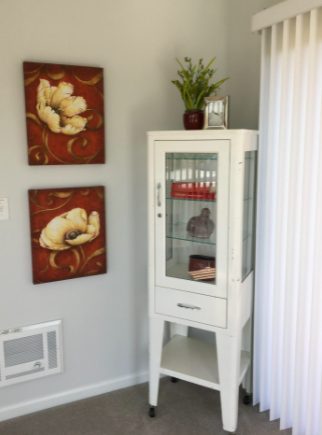Decorating Your Home After Downsizing: 5 Tips from an Interior Designer
Decorating your home after downsizing can be overwhelming. As an interior designer, I’ve walked clients through this decision-making process countless times.
Here are 5 tips to help you tackle the task of laying out your new space.
1. Define The Space
Decide how you will use the rooms. This is especially important in floor plans with an open concept. Create an imaginary line within that space and look at each as a distinct room. If your imagination isn’t enough:
- Place painter’s tape where you see the room divided.
- Put a rug centrally in the area to aid you in separating the space.

For rooms that will serve a dual purpose, anchor the furniture pieces into each area so that each space is well defined.
For example, if you have a dining room/living room area, place your dining table under your chandelier and anchor your buffet on the wall centered with the table.
It’s important to remember that the division of the space is not just in relation to furniture. Centering artwork in the defined space rather than on the entire length of the wall is suggested.
About Negative Space
If you don’t see any negative space, the untouched wall space surrounding your art and decor on your walls, that is an indicator that something is “off”. Don’t be afraid of a little negative space on the floor and the walls between areas. This allows your eye to visualize that there are indeed two different spaces.
2. Identify Walkways

As you’re decorating your home after downsizing, you’ll quickly discover the natural walkways. If you’re moving with a pet, allow them to explore and take note of how they are navigating the new space.
Major Walkways
For major walkways, typically those that lead you to a doorway, allow for 4 feet of space. This provides ample room for 2 people to walk side by side or pass each other
Minor Walkways
Areas that are accessed less frequently can be closer to 3 feet wide as they will not be used as often. These spaces may include areas behind a couch or console table.
Remember, it’s ok to not place all of your furniture against the walls. Depending on how big your space is, placing your furniture up against the walls can cause the conversation area to be too big.
3. Functional Use of Furniture
Making decisions about furniture pieces can be some of the most difficult parts of decorating your home after downsizing.

Here are the things you’ll want to consider:
- Is the piece necessary?
- Does it perform a function that cannot be replicated in another area of your home?
- Do you use the piece daily?
- Will it fit in your new space?
- What condition is it in? Many find that this is a great time to replace things, like mattresses, that have become worn or need to be replaced.
If you love a piece of furniture but it’s no longer needed, try to find a new purpose for it in your home. Here are some suggestions:
- A chest of drawers from your old guest room may work well in a foyer, or offer added storage for linens in your dining room.
- Use extra dining chairs in a corner of your bedroom or office. A small pillow or throw can dress it up and you can pull it out when you have guests.
- Have a dining table but no dining room? Take the leaves out and use it in a kitchen nook or sun room.
Thinking of different ways to use furniture pieces can breathe new life into them, and having them in your new home can provide you comfort. Do your best to make decisions so that the items you take serve a purpose either visually or functionally.
4. Think Up
Use vertical space to your advantage. Not only on the walls but in your closets, storage space or garage. Closet organizers no longer in use, may find a new purpose elsewhere. Disassemble or redesign them if need be.
Artwork

Stacking– If you have two similar pieces of art in the same style frames and size, you can stack them. Place them on your floor first and measure their height as a whole.
Hang them at so they so that they are centered at eye level. The bottom one will be hung lower than normal and the top one will be hung higher than normal. I usually like to put about a 3” space between the two frames.
Gallery Style– Consider putting together a gallery. Place all the pieces on the floor before hanging and make sure you look at them as a whole. Use different styles and shapes of art in your gallery.
For example, hang a rectangular canvas painting, round mirror, and a piece of metal art. I like to use equal space between each of the pieces. So, if there’s a 2” space between the canvas and the mirror, there should be a 2” space between the mirror and the metal art piece.
5. Lighting is Everything

Don’t rely solely on overhead lights to illuminate your space. Lamps add warmth and provide lighting for tasks or where you don’t need a full overhead.
Transform a Space
If you have a lamp on your TV console, turn the lamp on when you have guests. It will transform the space from a TV viewing area, to a conversation space.
Expand a Space
Use lamps in multiple areas of a room. Space them out so that all areas are illuminated. Light up corners if possible. For example, if you have a chair in the corner of a room, place a standing lamp next to it. This visually expands the room.
Light Bulbs
The type of light bulb you choose makes a huge difference. There are bulbs that cast a cold, blue light and there are bulbs that cast a warm, yellow light. The warmer the light, the better your space will feel.
Decorating your home after downsizing is about making the space your own. So don’t be afraid that you ‘won’t get it right’ the first time you place things. As you settle in you’ll learn what is best for you, and you can always make changes.
Looking for some other new secrets to living a healthy lifestyle? With this FREE A-Z guide on Living and Aging the Way You Want you can learn the ABCs of aging successfully. Download your PDF and start living the lifestyle you want.
Subscribe to Life Enriching Communities Blog
"*" indicates required fields